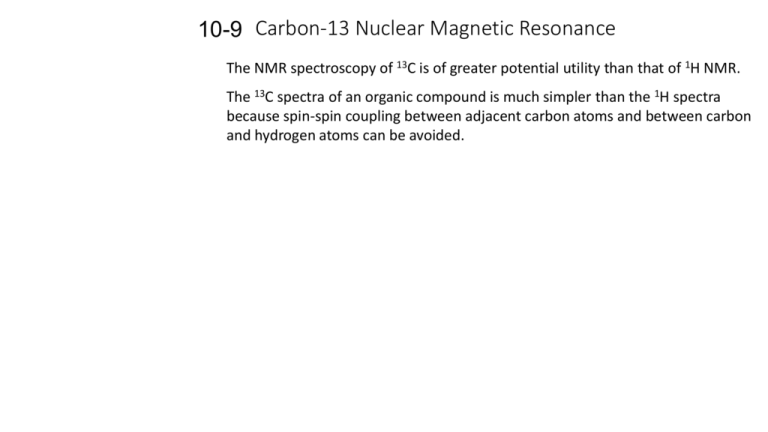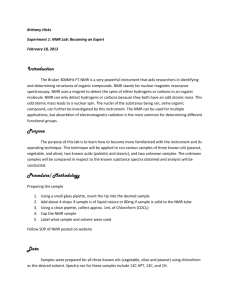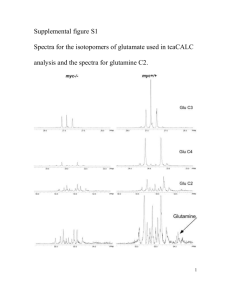Carbon-13 Nuclear Magnetic Resonance
advertisement

10-9 Carbon-13 Nuclear Magnetic Resonance The NMR spectroscopy of 13C is of greater potential utility than that of 1H NMR. The 13C spectra of an organic compound is much simpler than the 1H spectra because spin-spin coupling between adjacent carbon atoms and between carbon and hydrogen atoms can be avoided. Carbon NMR utilizes an isotope in low natural abundance: 13C. Carbon occurs as a mixture of two principle isotopes, 12C (98.89%) and 13C (1.11%). Of these, only 13C is active in NMR. Because of the low abundance of 13C and its weaker magnetic resonance (1/6000 as strong as 1H), FT NMR is usually used for 13C spectroscopy because multiple pulsing and signal averaging allows the accumulation of strong signals than would otherwise be possible. Carbon-carbon coupling is absent in 13C spectra due to the very low probability of two 13C nuclei being adjacent to each other in a single molecule (.0111 x .0111 ~ .0001). 13C-1H coupling is present, however, the chemical shift range of 13C is much greater than the splittings due to 1H, which precludes the overlapping of adjacent multiplets. The 13C chemical shifts are reported relative to an internal standard, usually (CH3)4Si. The 13C NMR spectra of bromoethane above exhibits 13C splitting by the methyl and methylene protons. The 13C peak due to C1 is first split by its own two hydrogens to produce a triplet. Each of the triplet peaks is then split into a quartet by the adjacent protons on the C2 carbon. The 13C peak due to C2 is first split by its own three hydrogens to produce a quartet. Each of the quartet peaks is then split into a triplet by the adjacent protons on the C1 carbon. Hydrogen decoupling give single lines. 13C-1H coupling can be completely removed by a technique called “broad-band hydrogen (or proton) decoupling.” In this technique, a strong broad radio frequency signal covering the entire resonant frequency range for hydrogen is simultaneously applied at the same time as the 13C signal. The broad-band hydrogen signal causes rapid - flips of the hydrogen nuclei, effectively averaging their local magnetic field contributions. Using this technique simplifies the spectra of bromoethane to two single lines. Proton decoupling is particularly powerful when analyzing complex molecules because every magnetically distinct carbon gives only a single peak. The decoupled 13C spectra of methylcyclohexane shows only five peaks, revealing the twofold symmetry in the structure. A limitation of FT 13C NMR spectroscopy is that, due to difficulties in integration, peak intensities (areas) no longer correspond to the numbers of nuclei present. Carbon, like hydrogen, has chemical shifts which depend upon its chemical environment. Electron withdrawing groups cause deshielding. The chemical shifts go up in order: primary < secondary < tertiary carbon. The numbers of non-equivalent carbons in the isomers of C7H14 are clearly demonstrated by the numbers of 13C peaks in their NMR spectra. Advances in FT NMR are greatly aiding structure elucidation: DEPT 13C and 2D-NMR. Using sophisticated time-dependent pulse sequences (two-dimensional NMR), it is now possible to establish coupling (e.g. bonding) between close-lying hydrogens (homonuclear correlation) or connected carbon and hydrogen atoms (heteronuclear correlation). This, in effect, determines the molecular connectivity of a molecule by measuring the magnetic effect of neighboring atoms on one another along a carbon chain. On such pulse sequence is the distortionless enhanced polarization transfer (DEPT) 13C NMR spectrum. DEPT gives information specifying which type of carbon gives rise to a specific signal in the normal 13C spectrum: CH3, CH2, CH, or Cquaternary. A DEPT experiment consists of three spectra: Normal broad-band decoupled spectra; DEPT-90 pulse sequence spectra, which reveals signals only of carbons bound to one hydrogen; DEPT-135 pulse sequence spectra which produces normal CH3 and CH signals, but negative absorptions for CH2 and no peaks for quaternary carbons. Limonene DEPT spectra: Spectrum A: All 10 lines – 6 alkyl C at high field, 4 alkenyl C at low field Spectrum B: CH carbons Spectrum C: CH carbons, positive signal CH3 carbons, negative signal CH2 carbons Spectrum A lines – Spectrum C lines: quaternary carbon We can apply 13C NMR spectroscopy to the problem of the monochlorination of 1-chloropropane. Both 1,1- and 1,2-dichloropropane should exhibit three carbon signals each. The groups of three signals would be spaced differently due to the different arrangement of chlorine substituents. 1,3-dichloropropane should exhibit only two carbon signals. The two deshielded chlorine bearing carbons assignments in 1,2-dichloropropane can be made using DEPT data. The signal at 49.5 ppm appears inverted in a DEPT135 spectrum (CH2). The signal at 55.8 ppm is the only absorption in a DEPT-90 spectrum








